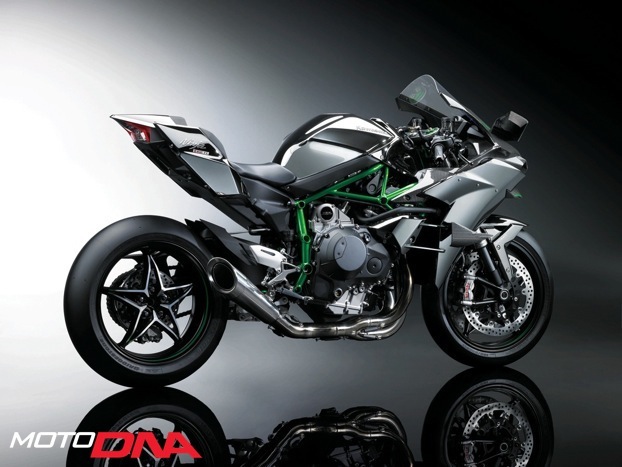There has been great hype around the launch of the new Kawasaki Ninja H2R, but does the bike live up to all the propaganda? Leveraging the history of the H2 legend, it’s a flashback to the 1970s for Kawasaki when the legendary triple was released into a sleepy market.
https://www.youtube.com/watch?v=GHBO5vSoMXo
The original Kawasaki H2 was a 750cc, 2-stroke with a reputation as one of the maddest things on two wheels. Nicknames included widow-maker and Bara Volante, or flying coffin, for a bike with a design brief declaring heaps of power, scary fast and drop-dead looks.
All will be truly revealed when we get to ride the thing, however in the meantime the new H2R is certainly living up to the hysteria so far. The detail design on this machine is exquisite; it’s beautifully engineered and makes unprecedented power. Kawasaki has created excitement amongst the motorcycling fraternity with something relatively new, fresh and extreme whilst also demonstrating their technical prowess. A predictable high price tag and limited numbers will sustain the exclusivity and hype for some time.
The latest H2R does promise to be more exciting to ride than its ancestor with a chassis that will clearly struggle to cope with excessive power of 300hp, more than even the latest MotoGP machinery. Obviously electronic rider aids will play a significant role in taming this beast, and it will be interesting to see how much technology Kawasaki employ to soften the bikes ride-ability with traction control, engine braking and launch control included, otherwise the handling could easily replicate the original H2 or Mach IV as it was know in the USA. The bike oozes carbon fiber bodywork and wind tunnel developed wings. Throw in black chrome paint and a truly original and cutting edge seat design and you have a stealthy looking flying machine.
Supercharger
To gain the huge power, Kawasaki have used their extensive resources at sister company, Kawasaki Heavy Industries Gas Turbine, to design an integrated centrifugal supercharger.
The definition of centrifugal is; moving or directed outward from the center, and gives some clues to how this supercharger works. Air from the huge H2R ram air duct enters the supercharger at the turbine axis and is then flung outward by the vanes, accelerating to a very high speed to pressurise the intake charge.
To understand how a supercharger creates more power first lets consider how a normally aspirated engine works. Simply speaking, an engine will suck, squeeze, bang and blow.
On the suck or intake stroke the engine relies on the displacement or swept volume to define how much air is drawn into the motor assisted by atmospheric pressure, which is around 1 bar or almost 15 psi.
The displacement or swept volume of the ZX10R engine is roughly 1000cc. However adding a supercharger, which is is basically an air pump, will dramatically increase the pressure or density of the air entering the engine.
If the supercharger has a boost of 5psi the total inlet charge pressure would be 20psi. Add more fuel with this extra air to get the correct air / fuel ratio and you get heaps more power.
Supercharger packaging on a bike is no easy business as the air is heated dramatically when it gets compressed. This goes against an engine’s ideal requirement of cool dense air for best combustion. Intercoolers are generally employed to cool that air down before the intake, but are not practical on a bike.
The H2R chassis gives some clues to how much heat will be generated and its not by accident that an open trellis frame has been used which will help keep the engine cooler albeit by seriously compromising chassis stiffness. However this lack of chassis stiffness will also keep the theme of an over powered engine in a lightweight short wheelbase chassis.
The H2R is the track only bike with the road version being released at EICMA in November. Bring on the test ride!
Questions on the H2R ? Ask away in the comments below.
Better than reading is some actual training – Learn how understanding motorcycle technology can improve your riding and much more at a motoDNA training day.
Photos by Kawasaki.
Data Driven
Developed from thousands of riders at the motoDNA Motorcycle Training, our algorithms measure, grade and train motorcycle riders.
Objective
No more guessing, data sensor fusion combined with our algorithms deeply understand rider behaviour.
Towards Zero
Our urgent and ambitious aim is to empower the motorcycle community to take back control towards zero.



